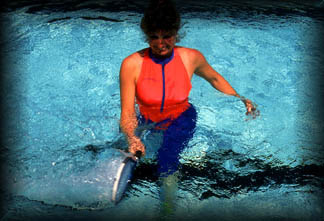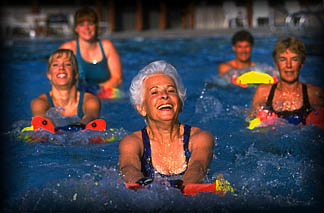

Aquatic Therapy is an integrated program of intervention, offered in a warm water pool for persons suffering from a variety of dysfunctional or chronic conditions. These programs are adapted to each individual's muscular skeletal condition. Aquatic fitness becomes a viable option to decrease the effects of gravity and decrease weight bearing, decrease joint compression forces, increase functional abilities and decrease the risk of falling as well as decrease swelling and pain. This provides the individual the opportunity to perform more potential movement than individuals may perform on land, at the same intensity. Program goals should be designed to maintain an individual's ADL's (activities of daily living) in terms of both range of motion and muscular strength and endurance.
Although there are never any guarantees to positive results, most of these conditions would benefit, with an appropriately designed aquatic fitness program, based on the protocols and systems of The American Academy of Health and Fitness Professionals. Under no circumstances should these protocols be used to diagnose or establish a treatment program for any medical condition. Each condition requires medical approval and a qualified instructor. There is an appropriate facility, with adequate accessibility for both the pool and change facilities.

Warmer pool temperatures should be emphasized, between 84-92 degrees Fahrenheit or 28-33 Celsius. The muscles contract, if exercised below 83 Fahrenheit, would not be able to optimize potential range of motion. If participants are utilizing less than optimal water temperatures or do not have the muscle mass to "heat" up the body, they should be encouraged to wear thermal gear, such as a vest, long tights, unitards, shoes, mitts. Yhis will help keep them thermoregulated. If the water temperature is too warm (above 88F) cardiovascular training may not be possible, as the participant may overheat too quickly.
Equipment for assisting buoyancy. such as an aquatic fitness belt, could be successfully utilized to gradually introduce the client to weight bearing walking in the shallow end. The use of such a belt is excellent for providing more stability, assist's with balance and learning functional exercises. It also introduces some upper body water weight exercises. Fit bands, (a continuous resistance band of 30 inches or 15 inches in length) may also be utilized to teach participants exercise in the water, that may also be performed on the land. Resistance bands and water fitness equipment are necessary to help the participant to strengthen "eccentricity" or the lengthening phase of the contraction, that is important for moving against gravity which is necessary (on land).
Here are some conditions or special populations that may benefit through aquatic fitness or therapy training. Also some program recommendations.
Anterior Cruciate Ligament Post Rehabilitation Program: As a primary stabilizer of the knee, during pivoting, twisting, and lateral motion, these movement patterns may be trained, in an un weight bearing position, initially in the deep water, may be graduated to shallower water, (chest depth) with a floatation device. Then ultimately to shallow water at waist depth, where they are 50% of their body weight. Strengthening exercises of the lower body, to help strengthen the muscles around the joint and increase range of motion in the knee joint, may also be programmed.
Impingement Syndrome Post Rehabilitation Program: Shoulder impingement is characterized by shoulder pain that occurs when a person moves their arm in an overhead position. Aquatic exercise may be utilized resistance. It may also take the stress off the joint, when the shoulder is trained under the water.
Low Back Pain:Low Back Pain affects 80% of the population at some point in their life. Regardless of the cause, (trauma, degeneration, genetic predisposition) low back pain responds well to a balanced total body conditioning program. Also a moderate, intensity, low or non impact, cardiovascular training program. Vertical or seated water exercise is especially beneficial at training the stabilizing "posture" muscles of the abdominals, back and hip abductors and adductor muscles.

Achilles Tendon Rupture: The rupture of the Achilles' tendon occurs, generally in middle aged men, during ballistic sports activities. Unloading the calve muscles during deep water training will provide a non impact environment to strengthen the lower leg musculature. Caution should be placed on wearing footwear or placing too much resistance (flexing feet) during moves or until the participant is strong enough to load the calve muscles.
Total Hip Replacement: Hip replacements are caused by degenerative changes in the hip. Through surgery the affected structure is replaced with a prosthesis. The reconstruction is stronger than the pre existing hip, but the person may need to develop unassisted weight bearing movement. Water exercise is an excellent way to graduate from deep to shallow water training so that they may be able to weight bear comfortably and increase mobility and strength around the hip joint
Total Knee Replacement: Arthritic changes or degeneration in the knees will cause such severe pain and dysfunction, that the individual will elect to have the knee replaced. The replacement joint may not be as durable as the actual human joint. Only improved quadriceps strength will aid in a significant return of the function of the knee. Backwards bicycling movements, in the deep water, will help them to achieve this. Also gradually performing aquatic step training in the shallow water, since it will load the quadriceps muscles.
Oesteoarthritis is cartilage degeneration that occurs in weight bearing joints, of individuals aged 45-90 years old. It is important to maximize functional strength and cardiovascular conditioning as well as maintain range of motion with a balanced water program.
Rheumatoid Arthritis is an inflammation of the joint lining (synovial membrane) as well as damage, destruction to internal joint structures, surrounding ligaments, tendons and joint capsule. It is common in 20-45 females or juvenile arthritis in children. It is important to manage inflammation and joint stability, with light muscular conditioning exercises, with full range of motion.
Fibromyalgia is common chronic pain syndrome, characterized by multiple pain locations. Aquatic exercise may provide increase in functional mobility, circulation, balance, coordination, as well as a decrease in stiffness. It is recommended to progress slowly and avoid fatigue from overexertion as well as utilize supervision throughout programming.
Pre-Post Natal Programs: It is generally accepted that expectant mothers may safely exercise throughout and after their pregnancy. Studies have suggested that, by being physically active, a women can more easily cope with the adaptation to motherhood and the increased demands on herself and the family. The water provides an environment for low, to non weight bearing, that takes weight off the vulnerable joints, provides support and makes the pregnant mum feel lighter and more comfortable, with a very low risk of injury. Active stretching of the low back helps to relieve back ache. The hydrostatic pressure of the water significantly reduces swelling in the lower limbs.
To market these types of programs, facilities should supply an appropriate description of the program and program goals. Emphasis should be placed on the education component of the session, so the participant may understand their condition and learn exercises that may help their well being. These programs may be led separately from a rehabilitation program, as a wellness or preventive program, as a means to bridge the gap from rehabilitation to fitness.
The instructor should take care to utilize the proper terminology and reference a "person with a disability" and a "person with a condition" rather than a "disabled person" or a "diseased person". Participants should be reminded that no two bodies or conditions are the same. They need to take responsibility for monitoring their pain or discomfort and perform as much of the program as they feel comfortable with. There has been a lot of talk about fitness and the seniors market and aquatic fitness is ideally suited to their requirements. So suit up and dive in!
Julie Twynham is with Speedo Aquatic Fitness Systems & Rikki Gross is a Medical Exercise Specialist & Speedo Certified Fitness Instructor.